Alexander Pope
Alexander Pope (21 May 1688 – 30 May 1744) is regarded as one of the greatest English poets, and the foremost poet of the early eighteenth century. He is best known for his satirical and discursive poetry, including The Rape of the Lock, The Dunciad, and An Essay on Criticism, as well as for his translation of Homer. After Shakespeare, Pope is the second-most quoted writer in the English language, per The Oxford Dictionary of Quotations,[1] some of his verses having even become popular idioms in common parlance (e.g., Damning with faint praise). He is considered a master of the heroic couplet.
Alexander Pope | |
|---|---|
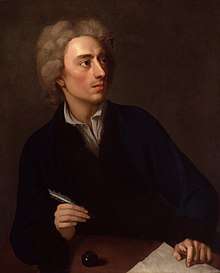 Pope c. 1727 | |
| Born | 21 May 1688 London, England |
| Died | 30 May 1744 (aged 56) Twickenham, Middlesex, England |
| Resting place | St Mary's Church, Twickenham, Middlesex, England |
| Occupation | Poet, writer, translator |
| Notable works | The Dunciad, The Rape of the Lock, An Essay on Criticism, His translation of Homer |
| Signature |  |
Pope's poetic career testifies to his indomitable spirit in the face of disadvantages, of health and of circumstance. The poet and his family were Catholics and thus fell subject to the Test Acts, prohibitive measures which severely hampered the prosperity of their co-religionists after the abdication of James II; one of these banned them from living within ten miles of London, and another from attending public school or university. For this reason, except for a few spurious Catholic schools, Pope was largely self-educated. He was taught to read by his aunt and became a lover of books. He learned French, Italian, Latin, and Greek by himself, and discovered Homer at the age of six. As a child Pope survived being once trampled by a cow, but when he was 12 began struggling with tuberculosis of the spine (Pott disease), along with fits of crippling headaches which troubled him throughout his life.
In the year 1709, Pope showcased his precocious metrical skill with the publication of Pastorals, his first major poems. They earned him instant fame. By the time he was 23 he had written An Essay on Criticism, released in 1711. A kind of poetic manifesto in the vein of Horace's Ars Poetica, the essay was met with enthusiastic attention and won Pope a wider circle of prominent friends, most notably Joseph Addison and Richard Steele, who had recently started collaborating on the influential The Spectator. The critic John Dennis, having located an ironic and veiled portrait of himself, was outraged by what he considered the impudence of the younger author. Dennis hated Pope for the rest of his life, and, save for a temporary reconciliation, dedicated his efforts to insulting him in print, to which Pope retaliated in kind, making Dennis the butt of much satire.
The Rape of the Lock, perhaps the poet's most famous poem, appeared first in 1712, followed by a revised and enlarged version in 1714. When Lord Petre forcibly snipped off a lock from Miss Arabella Fermor's head (the "Belinda" of the poem), the incident gave rise to a high-society quarrel between the families. With the idea of allaying this, Pope treated the subject in a playful and witty mock-heroic epic. The narrative poem brings into focus the onset of acquisitive individualism and conspicuous consumption, where purchased goods assume dominance over moral agency.
A folio comprising a collection of his poems appeared in 1717, together with two new ones written about the passion of love. These were Verses to the Memory of an Unfortunate Lady and the famous proto-romantic poem Eloisa to Abelard. Though Pope never married, about this time he became strongly attached to Lady M. Montagu, whom he indirectly referenced in the popular poem Eloisa to Abelard, and to Martha Blount, with whom his friendship continued throughout his life.
In his career as a satirist, Pope made his share of enemies as the critics, politicians, and certain other prominent figures felt the sting of his sharp-witted satires. Some were so virulent, that Pope even carried pistols at one point while walking his dog. After 1738, Pope composed relatively little. He toyed with the idea of writing a patriotic epic called Brutus. He mainly revised and expanded his masterpiece The Dunciad. Book Four appeared in 1742, and a complete revision of the whole poem in the following year. In this version, he replaced Lewis Theobald with the Poet Laureate Colley Cibber, as "king of dunces". However, his real target in the poem is the Whig politician Robert Walpole. By now Pope's health was failing, and when told by his physician, on the morning of his death, that he was better, Pope replied: "Here am I, dying of a hundred good symptoms."
Life
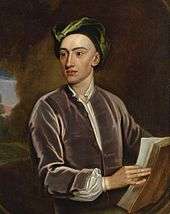
Early life
Alexander Pope was born in London on 21 May 1688, the year of the Glorious Revolution. His father (also Alexander, 1646–1717) was a successful linen merchant in the Strand. The poet's mother, Edith (1643–1733), was the daughter of William Turner, Esquire, of York. Both parents were Catholics.[3] Edith's sister, Christiana, was the wife of famous miniature painter Samuel Cooper. Pope's education was affected by the recently enacted Test Acts, which upheld the status of the established Church of England and banned Catholics from teaching, attending a university, voting, and holding public office on penalty of perpetual imprisonment. Pope was taught to read by his aunt and went to Twyford School in about 1698/99.[3] He then went on to two Roman Catholic schools in London.[3] Such schools, while illegal, were tolerated in some areas.[4]
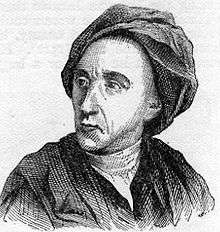
In 1700, his family moved to a small estate at Popeswood in Binfield, Berkshire, close to the royal Windsor Forest.[3] This was due to strong anti-Catholic sentiment and a statute preventing "Papists" from living within 10 miles (16 km) of London or Westminster.[6] Pope would later describe the countryside around the house in his poem Windsor Forest.[7] Pope's formal education ended at this time, and from then on, he mostly educated himself by reading the works of classical writers such as the satirists Horace and Juvenal, the epic poets Homer and Virgil, as well as English authors such as Geoffrey Chaucer, William Shakespeare and John Dryden.[3] He studied many languages and read works by English, French, Italian, Latin, and Greek poets. After five years of study, Pope came into contact with figures from London literary society such as William Congreve, Samuel Garth and William Trumbull.[3][4]
At Binfield he made many important friends. One of them, John Caryll (the future dedicatee of The Rape of the Lock), was twenty years older than the poet and had made many acquaintances in the London literary world. He introduced the young Pope to the ageing playwright William Wycherley and to William Walsh, a minor poet, who helped Pope revise his first major work, The Pastorals. He also met the Blount sisters, Teresa and Martha, both of whom remained lifelong friends.[4]
From the age of 12 he suffered numerous health problems, including Pott disease, a form of tuberculosis that affects the spine, which deformed his body and stunted his growth, leaving him with a severe hunchback. His tuberculosis infection caused other health problems including respiratory difficulties, high fevers, inflamed eyes and abdominal pain.[3] He grew to a height of only 1.37 m (4 ft 6 in). Pope was already removed from society as a Catholic, and his poor health alienated him further. Although he never married, he had many female friends to whom he wrote witty letters, including Lady Mary Wortley Montagu. It has been alleged that his lifelong friend Martha Blount was his lover.[4][8][9][10] His friend William Cheselden said, according to Joseph Spence, "I could give a more particular account of Mr. Pope's health than perhaps any man. Cibber's slander (of carnosity) is false. He had been gay, but left that way of life upon his acquaintance with Mrs. B."[11]
Early career

In May 1709, Pope's Pastorals was published in the sixth part of bookseller Jacob Tonson's Poetical Miscellanies. This earned Pope instant fame and was followed by An Essay on Criticism, published in May 1711, which was equally well received.

Around 1711, Pope made friends with Tory writers Jonathan Swift, Thomas Parnell and John Arbuthnot, who together formed the satirical Scriblerus Club. Its aim was to satirise ignorance and pedantry through the fictional scholar Martinus Scriblerus. He also made friends with Whig writers Joseph Addison and Richard Steele. In March 1713, Windsor Forest[7] was published to great acclaim.[4]
During Pope's friendship with Joseph Addison, he contributed to Addison's play Cato, as well as writing for The Guardian and The Spectator. Around this time, he began the work of translating the Iliad, which was a painstaking process – publication began in 1715 and did not end until 1720.[4]
In 1714 the political situation worsened with the death of Queen Anne and the disputed succession between the Hanoverians and the Jacobites, leading to the Jacobite rising of 1715. Though Pope, as a Catholic, might have been expected to have supported the Jacobites because of his religious and political affiliations, according to Maynard Mack, "where Pope himself stood on these matters can probably never be confidently known". These events led to an immediate downturn in the fortunes of the Tories, and Pope's friend Henry St John, 1st Viscount Bolingbroke, fled to France.
Pope lived in his parents' house in Mawson Row, Chiswick, between 1716 and 1719; the red brick building is now the Mawson Arms, commemorating him with a blue plaque.[12]
The money made from his translation of Homer allowed Pope to move in 1719 to a villa at Twickenham, where he created his now famous grotto and gardens. The serendipitous discovery of a spring during the excavation of the subterranean retreat enabled it to be filled with the relaxing sound of trickling water, which would quietly echo around the chambers. Pope was said to have remarked that: "Were it to have nymphs as well – it would be complete in everything." Although the house and gardens have long since been demolished, much of the grotto survives. It now lies beneath Radnor House Independent Co-ed School and is occasionally opened to the public.[8][13]
Poetry
Essay on Criticism
An Essay on Criticism was first published anonymously on 15 May 1711. Pope began writing the poem early in his career and took about three years to finish it.
At the time the poem was published, the heroic couplet style in which it was written was a moderately new poetic form, and Pope's work was an ambitious attempt to identify and refine his own positions as a poet and critic. The poem was said to be a response to an ongoing debate on the question of whether poetry should be natural, or written according to predetermined artificial rules inherited from the classical past.[14]
The 'essay' begins with a discussion of the standard rules that govern poetry by which a critic passes judgment. Pope comments on the classical authors who dealt with such standards and the authority that he believed should be accredited to them. He discusses the laws to which a critic should adhere while critiquing poetry, and points out that critics serve an important function in aiding poets with their works, as opposed to the practice of attacking them.[15] The final section of An Essay on Criticism discusses the moral qualities and virtues inherent in the ideal critic, who, Pope claims, is also the ideal man.
The Rape of the Lock
Pope's most famous poem is The Rape of the Lock, first published in 1712, with a revised version published in 1714. A mock-epic, it satirises a high-society quarrel between Arabella Fermor (the "Belinda" of the poem) and Lord Petre, who had snipped a lock of hair from her head without her permission. The satirical style is tempered, however, by a genuine and almost voyeuristic interest in the "beau-monde" (fashionable world) of 18th-century English society.[16] The revised and extended version of the poem brought more clearly into focus its true subject – the onset of acquisitive individualism and a society of conspicuous consumers. In the world of the poem, purchased artifacts displace human agency, and 'trivial things' assume dominance.[17]
The Dunciad and Moral Essays
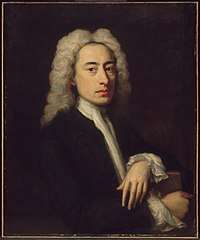
Though The Dunciad was first published anonymously in Dublin, its authorship was not in doubt. Pope pilloried a host of other "hacks", "scribblers" and "dunces" in addition to Theobald, and Maynard Mack has accordingly called its publication "in many ways the greatest act of folly in Pope's life." Though a masterpiece which would become "one of the most challenging and distinctive works in the history of English poetry", writes Mack, "it bore bitter fruit. It brought the poet in his own time the hostility of its victims and their sympathizers, who pursued him implacably from then on with a few damaging truths and a host of slanders and lies."[18]
According to his half-sister Magdalen Rackett, some of Pope's targets were so enraged by The Dunciad that they threatened him. "My brother does not seem to know what fear is," she told Joseph Spence, explaining that Pope loved to walk alone, so went accompanied by his Great Dane Bounce, and for some time carried pistols in his pocket.[19] Together with John Gay's The Beggar's Opera and Jonathan Swift's Gulliver's Travels, this first Dunciad was part of a concerted propaganda assault against Robert Walpole's Whig ministry and the financial revolution it stabilised. Although he was a keen participant in the stock and money markets, Pope never missed an opportunity to satirise the personal, social and political effects of the new scheme of things. From The Rape of the Lock onwards, these satirical themes are a constant in his work.
In 1731, Pope published his "Epistle to Burlington," on the subject of architecture, the first of four poems which would later be grouped under the title Moral Essays (1731–35). In the epistle, Pope ridiculed the bad taste of the aristocrat "Timon". Pope's enemies claimed he was attacking the Duke of Chandos and his estate, Cannons. Though the charge was untrue, it did Pope a great deal of damage.
An Essay on Man
An Essay on Man is a philosophical poem, written in heroic couplets and published between 1732 and 1734. Pope intended this poem to be the centrepiece of a proposed system of ethics that was to be put forth in poetic form. It was a piece of work that Pope intended to make into a larger work; however, he did not live to complete it.[20]
The poem is an attempt to "vindicate the ways of God to Man", a variation on Milton's attempt in Paradise Lost to "justify the ways of God to Man" (1.26). It challenges as prideful an anthropocentric world-view. The poem is not solely Christian, however; it makes an assumption that man has fallen and must seek his own salvation.[20]
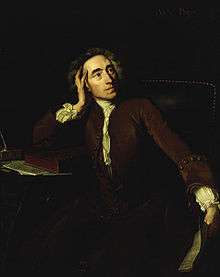
It consists of four epistles that are addressed to Lord Bolingbroke. Pope presents an idea on his view of the Universe; he says that no matter how imperfect, complex, inscrutable and disturbing the Universe appears to be, it functions in a rational fashion according to the natural laws. The natural laws consider the Universe as a whole a perfect work of God. To humans, it appears to be evil and imperfect in many ways. Pope points out that this is due to our limited mindset and limited intellectual capacity. Pope gets the message across that humans must accept their position in the "Great Chain of Being" which is at a middle stage between the angels and the beasts of the world. If we are able to accomplish this then we potentially could lead happy and virtuous lives.[20]
The poem is an affirmative poem of faith: life seems to be chaotic and confusing to man when he is in the centre of it, but according to Pope it is really divinely ordered. In Pope's world, God exists and is what he centres the Universe around in order to have an ordered structure. The limited intelligence of man can only take in tiny portions of this order and can experience only partial truths, hence man must rely on hope which then leads into faith. Man must be aware of his existence in the Universe and what he brings to it, in terms of riches, power, and fame. It is man's duty to strive to be good regardless of other situations: this is the message Pope is trying to get across to the reader.[21]
Later life and works
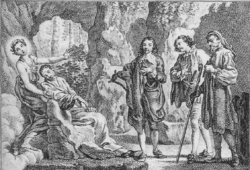
The Imitations of Horace followed (1733–38). These were written in the popular Augustan form of the "imitation" of a classical poet, not so much a translation of his works as an updating with contemporary references. Pope used the model of Horace to satirise life under George II, especially what he regarded as the widespread corruption tainting the country under Walpole's influence and the poor quality of the court's artistic taste.
Pope also added a wholly original poem, Epistle to Doctor Arbuthnot, as an introduction to the "Imitations". It reviews his own literary career and includes the famous portraits of Lord Hervey ("Sporus") and Addison ("Atticus"). In 1738 he wrote the Universal Prayer.[22]
Among the younger poets whose work Pope admired was Joseph Thurston.[23] After 1738, Pope himself wrote little. He toyed with the idea of composing a patriotic epic in blank verse called Brutus, but only the opening lines survive. His major work in these years was revising and expanding his masterpiece The Dunciad. Book Four appeared in 1742, and a complete revision of the whole poem in the following year. In this version, Pope replaced the "hero" Lewis Theobald with the Poet Laureate, Colley Cibber, as "king of dunces". However, the real focus of the revised poem is Walpole and all his works. By now Pope's health, which had never been good, was failing. When told by his physician, on the morning of his death, that he was better, Pope replied: "Here am I, dying of a hundred good symptoms."[24][25] He died in his villa surrounded by friends on 30 May 1744, about eleven o'clock at night. On the previous day, 29 May 1744, Pope had called for a priest and received the Last Rites of the Catholic Church. He was buried in the nave of St Mary's Church, Twickenham.
Translations and editions
Translation of the Iliad
Pope had been fascinated by Homer since childhood. In 1713, he announced his plans to publish a translation of the Iliad. The work would be available by subscription, with one volume appearing every year over the course of six years. Pope secured a revolutionary deal with the publisher Bernard Lintot, which earned him two hundred guineas (£210) a volume, a vast sum at the time.
His translation of the Iliad appeared between 1715 and 1720. It was acclaimed by Samuel Johnson as "a performance which no age or nation could hope to equal" (although the classical scholar Richard Bentley wrote: "It is a pretty poem, Mr. Pope, but you must not call it Homer.")
Translation of the Odyssey
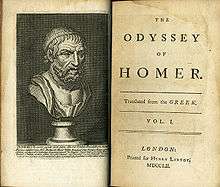
Encouraged by the success of the Iliad, Bernard Lintot published Pope's five-volume translation of Homer's Odyssey in 1725 and 1726.[26] For this work, Pope collaborated with William Broome and Elijah Fenton: Broome translated eight books (2, 6, 8, 11, 12, 16, 18, 23); Fenton four (1, 4, 19, 20); and Pope the remaining 12. Broome provided the annotations.[27] Pope attempted to conceal the extent of the collaboration,[28] but the secret leaked out. It did some damage to Pope's reputation for a time, but not to his profits.[29] Leslie Stephen considered Pope's portion of the Odyssey inferior to his version of the Iliad, given that Pope had put more effort into the earlier work – to which, in any case, his style was better suited.[30]
Edition of Shakespeare's works
In this period, Pope was employed by publisher Jacob Tonson to produce an opulent new edition of Shakespeare.[31] When it appeared in 1725, this edition silently regularised Shakespeare's metre and rewrote his verse in a number of places. Pope also removed about 1,560 lines of Shakespearean material, arguing that some appealed to him more than others.[31] In 1726, lawyer, poet and pantomime deviser Lewis Theobald published a scathing pamphlet called Shakespeare Restored, which catalogued the errors in Pope's work and suggested a number of revisions to the text. This enraged Pope, and thus, Theobald was the main target of Pope's poem The Dunciad.[32]
The second edition of Pope's Shakespeare appeared in 1728.[31] Aside from making some minor revisions to the preface, it seems that Pope had little to do with it. Most, later 18th-century editors of Shakespeare dismissed Pope's creatively motivated approach to textual criticism. Pope's preface continued to be highly rated. It was suggested that Shakespeare's texts were thoroughly contaminated by actors' interpolations and they would influence editors for most of the 18th century.
Reception
By the mid-18th century, new fashions in poetry emerged. A decade after Pope's death, Joseph Warton claimed that Pope's style of poetry was not the most excellent form of the art. The Romantic movement that rose to prominence in early 19th-century England was more ambivalent towards his work. Though Lord Byron identified Pope as one of his chief influences – believing his scathing satire of contemporary English literature English Bards and Scotch Reviewers to be a continuance of Pope's tradition) – William Wordsworth found Pope's style fundamentally too decadent to be a representation of the human condition.[4] George Gilfillan in his study of 1856 described Pope's talent as "a rose peering into the summer air, fine, rather than powerful".[33]
In the 20th century, Pope's reputation revived. Pope's work was, of course, full of references to the people and places of his time, and these aided people's understanding of the past. The post-war period stressed the power of Pope's poetry, recognising that Pope's immersion in Christian and Biblical culture lent depth to his poetry. For example, Maynard Mack, a Pope scholar of the later 20th century, argued that Pope's moral vision demanded as much respect as his technical excellence. Between 1953 and 1967 the definitive Twickenham edition of Pope's poems was published in ten volumes, including an index volume.[4]
Works
Major works
- 1709: Pastorals
- 1711: An Essay on Criticism[34]
- 1712: Messiah (from the Book of Isaiah, and later translated into Latin by Samuel Johnson)
- 1712: The Rape of the Lock (enlarged in 1714)[34]
- 1713: Windsor Forest[7][34]
- 1715: The Temple of Fame: A Vision[35]
- 1715–1720: Translation of the Iliad[34]
- 1717: Eloisa to Abelard[34]
- 1717: Three Hours After Marriage, with others
- 1717: Elegy to the Memory of an Unfortunate Lady[34]
- 1723–1725: The Works of Shakespear, in Six Volumes
- 1725–1726: Translation of the Odyssey[34]
- 1727: Peri Bathous, Or the Art of Sinking in Poetry
- 1728: The Dunciad[34]
- 1733–1734: Essay on Man[34]
- 1735: The Prologue to the Satires (see the Epistle to Dr Arbuthnot and Who breaks a butterfly upon a wheel?)
Other works
- 1700: Ode on Solitude
- 1713: Ode for Musick[36]
- 1717: The Court Ballad[37]
- 1731: An Epistle to the Right Honourable Richard Earl of Burlington[38]
- 1733: The Impertinent, or A Visit to the Court[39]
- 1736: Bounce to Fop[40]
- 1737: The First Ode of the Fourth Book of Horace[41]
- 1738: The First Epistle of the First Book of Horace[42]
References
- Dictionary of Quotations (1999)
- Portrait of Alexander Pope (1688–1744). Historical Portraits Image Library. Retrieved 1 January 2017.
- Erskine-Hill, DNB
- 'Alexander Pope', Literature Online biography (2000)
- "National Portrait Gallery – Portrait – NPG 299; Alexander Pope". npg.org.uk.
- "An Act to prevent and avoid dangers which may grow by Popish Recusants" (3. Jac. 1, v). For details, see Catholic Encyclopedia, "Penal Laws".
- Pope, Alexander. Windsor-Forest. Eighteenth-Century Poetry Archive (ECPA).
- Gordon (2002)
- 'Mount', Britannica (2009)
- The Life of Alexander Pope, by Robert Carruthers, 1857, with a corrupted and badly scanned version available from Internet Archive, or as an even worse 23MB PDF. For reference to his relationship with Martha Blount and her sister, see pp. 64–68 (p. 89 ff. of the PDF). In particular, discussion of the controversy over whether the relationship was sexual is described in some detail on pp. 76–78.
- Zachary Cope, William Cheselden, 1688–1752. Edinburgh: E. & S. Livingstone, 1953, p. 89.
- Clegg, Gillian. "Chiswick History". People: Alexander Pope. chiswickhistory.org.uk. Retrieved 16 March 2012.
- London Evening Standard, 2 November 2010
- Rogers (2006)
- Baines (2001).
- "from the London School of Journalism". Archived from the original on 31 May 2008.
- Colin Nicholson, Writing and the Rise of Finance: Capital Satires of the Early Eighteenth Century (Cambridge 1994).
- Maynard Mack. Alexander Pope: A Life (W. W. Norton & Company, and Yale University Press, 1985), pp. 472–473.
- Joseph Spence. Observations, Anecdotes, and Characters of Books and Men, Collected from the Conversation of Mr. Pope (1820), p. 38.
- Nuttal (1984)
- Cassirer (1944).
- Trevor W. McKeown. "Alexander Pope 'Universal Prayer'". bcy.ca. Full-text. Also at the Eighteenth-Century Poetry Archive (ECPA).
- ODNB Retrieved 16 June 2020.
- Ruffhead, Owen (1769). The Life of Alexander Pope; With a Critical Essay on His Writings and Genius. p. 475.
- Dyce, Alexander (1863). The Poetical Works of Alexander Pope, with a Life, by A. Dyce. p. cxxxi.
- Homer (1725–1726). The Odyssey of Homer. Translated by Alexander Pope; William Broome & Elijah Fenton (1st ed.). 5 vols. London: Bernard Lintot.CS1 maint: location (link)
- Fenton, Elijah (1796). The poetical works of Elijah Fenton with the life of the author. Printed for, and under the direction of, G. Cawthorn, British Library, Strand. p. 7.
- Fraser, George (1978). Alexander Pope. Routledge. p. 52.
- Damrosch, Leopold (1987). The Imaginative World of Alexander Pope. University of California Press. p. 59.
- Stephen, Sir Leslie (1880). Alexander Pope. Harper & Brothers. pp. 80.
- "Preface to Shakespeare, 1725, Alexander Pope". ShakespeareBrasileiro. Retrieved 10 March 2020.
- George Gilfillan, The Genius and Poetry of Pope, The Poetical Works of Alexander Pope, Vol. 11, 1856.
- Cox, Michael, editor, The Concise Oxford Chronology of English Literature, Oxford University Press, 2004, ISBN 0-19-860634-6
- Pope, Alexander. The Temple of Fame: A Vision. London: Printed for Bernard Lintott, 1715. Print.
- Pope, Alexander. ODE FOR MUSICK.. Eighteenth-Century Poetry Archive (ECPA).
- Pope, Alexander. The Court Ballad. Eighteenth-Century Poetry Archive (ECPA).
- Pope, Alexander. Epistle to Richard Earl of Burlington. Eighteenth-Century Poetry Archive (ECPA).
- Pope, Alexander. The IMPERTINENT, or A Visit to the COURT. A SATYR.. Eighteenth-Century Poetry Archive (ECPA).
- Pope, Alexander. Bounce to Fop. Eighteenth-Century Poetry Archive (ECPA).
- Pope, Alexander. THE FIRST ODE OF THE FOURTH BOOK OF HORACE.. Eighteenth-Century Poetry Archive (ECPA).
- Pope, Alexander. THE FIRST EPISTLE OF THE FIRST BOOK OF HORACE.. Eighteenth-Century Poetry Archive (ECPA).
Bibliography
- 'Alexander Pope', Literature Online biography (Chadwyck-Healey: Cambridge, 2000).
- The Oxford Dictionary of Quotations (5th ed.). Oxford University Press. 1999.
- "Martha Blount". Encyclopædia Britannica. 2009. Retrieved 17 April 2009.
- Baines, Paul (2001). The Complete Critical Guide to Alexander Pope. Routledge Publishing. pp. 67–90.
- Cassirer, Ernst (1944). An Essay on Man; an introduction to a philosophy of human culture. Yale University Press.
- Davis, Herbert, ed. (1966). Poetical Works. Oxford Standard Authors. London: Oxford U.P.
- Erskine-Hill, Howard. 'Pope, Alexander (1688–1744)', Oxford Dictionary of National Biography (Oxford University Press, September 2004, online edn, January 2008). Accessed 18 April 2009
- Gordon, Ian (24 January 2002). "An Epistle to a Lady (Moral Essay II)". The Literary Encyclopedia. Retrieved 17 April 2009.
- Mack, Maynard (1985). Alexander Pope: A Life. New Haven: Yale University Press. (the definitive biography)
- Nicholson, Colin (1994). Writing and the Rise of Finance: Capital Satires of the Early Eighteenth Century, Cambridge
- Ostrom, Hans."Pope's Epilogue to the Satires, 'Dialogue I'." Explicator, 36:4 (1978), pp. 11–14.*Nuttal, Anthony (1984). Pope's Essay on Man. Allen & Unwin. pp. 3–15, 167–188.
- Rogers, Pat (2006). The Major Works. Oxford University Press. pp. 17–39.
- Rogers, Pat (2007). The Cambridge Companion to Alexander Pope. Cambridge: Cambridge University Press.
External links
| Wikimedia Commons has media related to Alexander Pope. |
| Wikiquote has quotations related to: Alexander Pope |
| Wikisource has original works written by or about: Alexander Pope |
| Wikisource has the text of the 1885–1900 Dictionary of National Biography's article about Pope, Alexander (1688–1744). |
- Alexander Pope at the Eighteenth-Century Poetry Archive (ECPA)
- Works by Alexander Pope at Project Gutenberg
- Works by or about Alexander Pope at Internet Archive
- Works by Alexander Pope at LibriVox (public domain audiobooks)

- John Wilkes and Alexander Pope – UK Parliament Living Heritage
- Lennox, Patrick Joseph (1911). . Catholic Encyclopedia. 12.
- BBC audio file. In Our Time, radio 4 discussion of Pope.
- University of Toronto "Representative Poetry Online" page on Pope
- Pope's Grave
- The Twickenham Museum
- Pope's Grotto Preservation Trust
- Richmond Libraries' Local Studies Collection. Local History. Accessed 2010-10-19
- "Archival material relating to Alexander Pope". UK National Archives.

- Portraits of Alexander Pope at the National Portrait Gallery, London

- Images relating to Alexander Pope at the English Heritage Archive
- Blue Plaque at 110 Chiswick Lane South, Chiswick, London W4 2LR